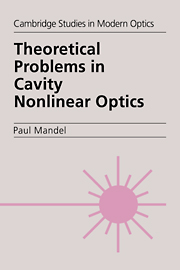Book contents
- Frontmatter
- Contents
- Introduction
- 1 Reduction of the Maxwell–Schrödinger equations
- 2 Parameter swept across a steady bifurcation I
- 3 Parameter swept across a steady bifurcation II
- 4 Optical bistability: Constant input
- 5 Optical bistability: Variable input
- 6 Multimode optical bistability
- 7 Free-running multimode lasers
- 8 Antiphase dynamics
- 9 Laser stability
- 10 Second harmonic generation
- 11 Saturable absorbers
- 12 Transverse effects in optical bistability
- Index
1 - Reduction of the Maxwell–Schrödinger equations
Published online by Cambridge University Press: 16 October 2009
- Frontmatter
- Contents
- Introduction
- 1 Reduction of the Maxwell–Schrödinger equations
- 2 Parameter swept across a steady bifurcation I
- 3 Parameter swept across a steady bifurcation II
- 4 Optical bistability: Constant input
- 5 Optical bistability: Variable input
- 6 Multimode optical bistability
- 7 Free-running multimode lasers
- 8 Antiphase dynamics
- 9 Laser stability
- 10 Second harmonic generation
- 11 Saturable absorbers
- 12 Transverse effects in optical bistability
- Index
Summary
A rigorous description of the light–matter interaction requires the use of quantized Maxwell equations to describe the light field and the Schrödinger equation to describe the material medium. This book does not attempt to deal with quantum optical problems that necessitate a field quantization. Instead we focus on properties that are generally grouped under the umbrella of nonlinear optics. Although many definitions of this expression exist, we use it in the sense that the properties we deal with do not depend in a crucial way on the field quantization. For practical purposes, this means in general that the average photon number is large and that we can neglect spontaneous emission as a dynamical process. Rather, we include the consequence of spontaneous emission, that is, the instability of the atomic levels, in a purely phenomenological way. When this is done, we call the material equations the Bloch equations instead of the Schrödinger equation. References [1] through [4] are the classical textbooks that contain a tentative justification for the transition from the Schrödinger to the Bloch equations. None of these attempts is satisfactory from a fundamental viewpoint because the real difficulty is to incorporate the finite lifetime (or natural linewidth) of the atomic energy levels in the Schrödinger equation. This remains an open problem as of now.
The Maxwell–Schrödinger equations
We consider atoms interacting with an intense electromagnetic field. By intense we mean a field for which the quantization is not necessary.
- Type
- Chapter
- Information
- Theoretical Problems in Cavity Nonlinear Optics , pp. 1 - 14Publisher: Cambridge University PressPrint publication year: 1997



